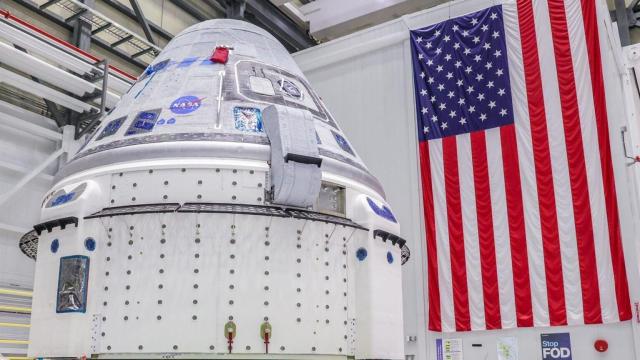Following several delays and over $1 billion in losses, Boeing claims its troubled Starliner program will be ready to launch crews to the International Space Station (ISS) by early 2024 as it works to resolve two safety hazards on its capsule.
“We’re anticipating that we’re going to be ready with the spacecraft in early March,” Mark Nappi, Boeing vice president and program manager for Starliner, said during a press conference on Monday. “That does not mean that we have a launch date in early March…we’re now working with NASA Commercial Crew Program, ISS and [United Launch Alliance] on special launch dates based on our readiness.”
Starliner was scheduled for launch on July 21 for a crewed test flight, carrying NASA astronauts Sunita Williams and Barry “Butch” Wilmore to the ISS. A few weeks before its liftoff, however, Boeing announced an indefinite delay to Starliner’s launch date due to the surfacing of two major safety issues. Now, Boeing and NASA are claiming that they have come up with solutions to the capsule’s safety hazards.
“NASA and Boeing put in place several different layers of independent reviews to work through the issues and to make sure that we didn’t have anything else out there,” Steve Stich, manager of NASA’s Commercial Crew Program, said during the press conference.
The first problem had to do with the load capacity of Starliner’s three parachutes, which are designed to ensure a safe landing for the crew vehicle. The fabric sections of the parachutes have a failure load limit lower than anticipated, implying that if one parachute fails, the remaining two would be incapable of adequately decelerating the spacecraft for its landing in New Mexico.
In order to resolve the issue, the team behind Starliner has redesigned the parachute’s “soft links,” which attach the parachute to the capsule, according to Stich. A parachute drop test is planned for mid-to-late November, with the final parachute scheduled to be delivered later in December.
The second issue involved hundreds of feet of protective tape used to insulate the wiring harnesses inside the Starliner vehicle, which were discovered to be flammable. The team has removed a “substantial” amount of the flammable tape from the vehicle, according to Stich. “We’ve also developed a few techniques to mitigate propagations should anything happen and additional tape to apply,” he added.
Even after resolving these issues and getting the vehicle ready for flight, Boeing still has to consider the space station’s schedule, as well as the availability of ULA’s Atlas V rocket, which will carry Starliner to orbit, before deciding on a launch date.
Despite the several issues that have plagued Boeing’s Starliner program, NASA still seems committed to having a second commercial partner launch its astronauts to the ISS. “I’ll tell you from an ISS standpoint, the Starliner vehicle remains a high priority to the space station program,” Joel Montalbano, manager of NASA’s ISS Program, said during the press conference.
The company is under a $US4.3 billion contract with NASA to transport astronauts back and forth to the ISS on board the CST-100 Starliner, the same way that the space agency’s other commercial partner SpaceX does using its Dragon capsule. Except SpaceX is way ahead of the game, recently launching its sixth crew to the ISS while Boeing still remains at zero.
For Boeing, it’s a fixed-price contract, so the company is having to cover all overage costs. The company recently announced further losses to the Starliner program based on its second quarter 2023 financial earnings statement, revealing an additional $US257 million hit. Boeing’s total losses on the Starliner mission now amount to a staggering $US1.14 billion.
Boeing’s Starliner crewed test flight was originally scheduled for February and then later moved to late April before its latest July launch date. The test flight is meant to usher in the final process of certifying the Starliner spacecraft for regular crewed flights to the ISS.
The space station is set to retire in 2030, so Boeing is on a tight deadline to ensure that enough of its crewed capsules reach the ISS to make this entire ordeal somewhat worth it. “Our plan all along has been to have two different, unique and diverse space transportation systems,” Stich said. “We’re working hard to get that in place.”
